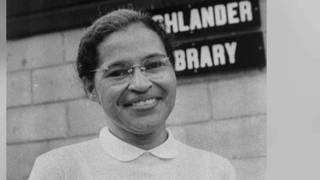
Related
Guests
- Claudette Colvina pioneer in the civil rights movement. In March 1955, she was the first person arrested for resisting bus segregation in Montgomery, Alabama. Her refusal to give up her seat to a white person came nine months before Rosa Parks and helped spark the historic Montgomery bus boycott. Her legal challenge went all the way to the Supreme Court. That case led the court to order an end to bus segregation in Alabama.
- Jeanne Theoharisauthor of The Rebellious Life of Mrs. Rosa Parks. She is a professor of political science at Brooklyn College and has written extensively about the civil rights and Black Power movements.
At a ceremony unveiling a statue in her honor last month, President Obama called Rosa Parks’ refusal to give up her seat on a Montgomery, Alabama, city bus a “singular act of disobedience.” But nine months before Parks’ historic action, a 15-year-old teenager named Claudette Colvin did the very same thing. She was arrested, and her case led to the U.S. Supreme Court’s order for the desegregation of Alabama’s bus system. Now 73, Claudette Colvin joins us for a rare interview along with Brooklyn College Professor Jeanne Theoharis, author of “The Rebellious Life of Mrs. Rosa Parks.” Theoharis says Parks’ act of defiance may not have happened if not for Colvin’s nine months before. Colvin says learning about African-American history in school inspired her act. “I could not move, because history had me glued to the seat,” she recalls telling the bus driver and the police officer who came to arrest her. “It felt like Sojourner Truth’s hands were pushing me down on one shoulder and Harriet Tubman’s hands were pushing me down on another shoulder.” [includes rush transcript]
Transcript
JUAN GONZÁLEZ: Earlier this year, the nation marked the 100th anniversary of the birth of Rosa Parks, who refused to give up her seat on a city bus in Alabama to a white man in December 1955. Her act of resistance led to a 13-month boycott, the Montgomery bus boycott, led by a young minister named Martin Luther King. In Washington, D.C., last month, President Obama presided over a ceremony unveiling a statue of Rosa Parks in the U.S. Capitol.
PRESIDENT BARACK OBAMA: Rosa Parks’ singular act of disobedience launched a movement. The tired feet of those who walked the dusty roads of Montgomery helped a nation see that to which it had once been blind. It is because of these men and women that I stand here today. It is because of them that our children grow up in a land more free and more fair, a land truer to its founding creed.
JUAN GONZÁLEZ: While Rosa Parks became a national civil rights icon, she was not the first woman in Montgomery to refuse to give up her seat on a city bus. On March 2nd, 1955, nine months before Rosa Parks’ arrest, a teenage schoolgirl named Claudette Colvin boarded a city bus after school to head home. As it filled up, a white woman was left standing, and the bus driver ordered the 15-year-old Colvin to get up and move to the back. She refused and was dragged off the bus in handcuffs. Three weeks later, The New York Times ran an article headlined “Negro Girl Convicted; She Is Held Guilty of Refusing to Move to Back of Bus.”
AMY GOODMAN: Claudette Colvin went on to become the star witness in a case that wound its way to the Supreme Court. The court eventually ordered an end to bus segregation in Alabama. The Reverend Dr. Martin Luther King Jr. made his political debut fighting her arrest.
Claudette Colvin joins us here in our studio, now 73 years old, living in the Bronx. And we’re joined by Jeanne Theoharis, author of The Rebellious Life of Mrs. Rosa Parks . Jeanne Theoharis is a professor of political science at Brooklyn College, has written extensively on the civil rights and Black Power movements, joined us in February on what would have been Rosa Parks’ 100th birthday.
Claudette Colvin, President Obama talked about Rosa Parks’ “singular act,” but it wasn’t exactly singular because you had done it before, nine months before. She was 42; you were 15 years old. What gave you the courage that day? You were coming home from school?
CLAUDETTE COLVIN: Yes. What gave me the courage? All the unfair treatment that I had experienced in my early childhood. Plus, you remember, February, we celebrated Negro History Week, but our school did it for the whole month. So I had a whole month to talk about all the injustices.
AMY GOODMAN: Back in ’55?
CLAUDETTE COLVIN: Back in ’55, yes. So, I tell them, we had an instructor named Ms. Geraldine Nesbitt, my—she refused to teach English. She taught literature. And Mrs. Josie Lawrence, my history teacher, she taught us about Africa. And we learned about—even we learned about—through current events, we learned about Africa. And so, I began to think about all of this and how unfair we was treated.
JUAN GONZÁLEZ: And when you were—the bus driver called in the police, they accused you of resisting arrest, as well as refusing to give up your seat. Could you talk about that and when the police came in to haul you off the bus?
CLAUDETTE COLVIN: I tell—one of the questions asks, “Why didn’t you get up when the bus driver asked you, and the policemen?” I say, “I could not move, because history had me glued to the seat.” And they say, “How is that?” I say, “Because it felt like Sojourner Truth’s hands were pushing me down on one shoulder and Harriet Tubman’s hands were pushing me down on another shoulder, and I could not move. And I yelled out, ’It’s my constitutional rights,’” because I wasn’t breaking a law under the state’s law, separate but equal; I was sitting in the area that was reserved for black passengers. At that time, we didn’t even want to be called “black,” because black had a negative connotation. We were called “coloreds.” So I was sitting in the coloreds’ section. But because of Jim Crow law, the bus driver had police force, he could ask you to get up. And the problem was that the white woman that was standing near me, she wasn’t an elderly white woman. She was a young white woman. She had a whole seat to sit down by—opposite me, in the opposite row, but she refused to sit down; because of Jim Crow laws, a white person couldn’t sit opposite a colored person. And a white person had to sit in front of you. The purpose was to make white people feel superior and colored people feel inferior.
AMY GOODMAN: And this is something you clearly understood at the age of 15.
CLAUDETTE COLVIN: Oh, sure, because I didn’t have to prepare for it. You learn—I learned it at a very early age. My first encounter was in a general store, when a little white boy—a little white kid about my age and his friend’s relatives came into the store, and they were laughing. And they were laughing about me. And the little boy, to another little child, said, “Hold up your hands. Let me see! Let me see!” And I held up my hands to his hand, and my mother gave me a backhand slap on the forehead.
JUAN GONZÁLEZ: And the context of what was happening at the time, in terms of the terror on the black community, there was a schoolmate of yours who was arrested for supposedly raping a white woman, who was then later executed?
CLAUDETTE COLVIN: Yes, his name was Jeremiah Reeves. He was—they had him arrested, but he was tried for being a serial rapist of six white women during the summer.
AMY GOODMAN: So the police come, March 2nd—
CLAUDETTE COLVIN: Yes.
AMY GOODMAN: —1955. You’re refusing to get up. When they come on the bus, what do they do to you?
CLAUDETTE COLVIN: Well, they asked me to get up, and I refused. And one of the policemen was a traffic policeman at Court Square. And he yelled to the bus motorman that he had no jurisdiction here, and he got off. So the bus driver moved the bus to Bibb and Commerce, and then two squad car policemen came on the bus. And they—I became more defiant. And when they asked me the same question, and the gal, “Why are you sitting there?” I said, “It’s my constitutional right. I paid my fare; it’s my constitutional right.” And he said, “Constitutional rights?” And then one kicked at me, and when one—and he knocked the books out of my hand—out of my lap. And then one grabbed one arm, and one grabbed the other, and they manhandled me off the bus. And after I got into the squad car, they handcuffed me through the window and took me to booking and then to—not to a juvenile facility, but to an adult jail. And I stayed in jail three—approximately three hours, until my pastor, Reverend H.H. Johnson, and my mother came and bailed me out.
AMY GOODMAN: Were you afraid?
CLAUDETTE COLVIN: No, I wasn’t afraid. I was a teenager.
AMY GOODMAN: You were in the NAACP?
CLAUDETTE COLVIN: Not at that time. I wasn’t in it when I got arrested. I was in—E.D. Nixon is like our Al Sharpton, and I was introduced—he introduced Mrs. Parks to my family. That’s how I learned about Mrs. Parks, through E.D. Nixon.
AMY GOODMAN: And he was president of the local NAACP, and she the secretary?
CLAUDETTE COLVIN: I don’t know. He was—no, I think he was in charge of the Pullman porters.
JUAN GONZÁLEZ: And the reaction of your parents, your family, to your arrest?
CLAUDETTE COLVIN: Oh, my family knew about it. They knew about how I felt, because since Mrs. Josie Lawrence was teaching us about Africa, I went to school with my hair in braids. And at that time, you had to do the best you could do with a hot comb and pomade. So I said, “Why put yourself through that trouble?” You know. So, when I went to school like that, they said, oh, I was crazy and that I would lose all my—I would lose my boyfriend.
AMY GOODMAN: Ah. So, this happened March 2nd, 1955.
CLAUDETTE COLVIN: Yes.
AMY GOODMAN: It would be nine months before Rosa Parks would sit down on the bus and do exactly the same thing.
CLAUDETTE COLVIN: Yes.
AMY GOODMAN: That kicked off this kind of magic moment that kicks off the bus boycott. Why didn’t that happen on March 2nd, when you engaged in the same act?
CLAUDETTE COLVIN: I do not know. I wasn’t—my parents wasn’t involved in the MIA. I do not know.
AMY GOODMAN: Mean, Montgomery Improvement Association.
CLAUDETTE COLVIN: Yes. I don’t know, but they thought that I would not make a good test case. I know what was written in a Taylor Branch book, Parting the Waters, and what the attorneys have said, that later I became pregnant. But I was not pregnant on March the 2nd. And Mary Louise Smith Ware, they said her father was a drunk, an alcoholic. But Mary Louise Smith went to a private school, St. Jude. She graduated from St. Jude.
AMY GOODMAN: And she was? Who was she?
CLAUDETTE COLVIN: She was one of the plaintiffs. She was arrested in October.
AMY GOODMAN: Let’s bring Jeanne Theoharis into this conversation, who wrote the book this past year, The Rebellious Life of Mrs. Rosa Parks. Can you put Claudette Colvin’s remarkably brave act, 15-year-old schoolgirl, into this larger political context, why one action gets a lot of attention in Montgomery, but doesn’t launch the boycott, and yet Rosa Parks does, and even the other young woman that Claudette Colvin was just talking about?
JEANNE THEOHARIS: Right. So, this is 1955. We’re after the Brown decision, so this is a new legal moment. And so—
AMY GOODMAN: Explain the Brown.
JEANNE THEOHARIS: Brown v. Board of Education, it’s May 1954. The Supreme Court rules that school segregation is illegal, that separate cannot be equal. Shortly after that, Jo Ann Robinson—she’s a professor at Alabama State College, she’s also the head of the Women’s Political Council—writes a letter to the bus company saying, “If you don’t change, we’re going to boycott.” So we are in a new moment in Montgomery. There had been people before 1954 that had resisted on the bus. There had been particularly more people in the decade since World War II. But 1954, we’re in a new moment. The Women’s Political Council had been organizing, the NAACP. E.D. Nixon and Rosa Parks, in particular, are the more activist part of the NAACP. They are growing frustrated with the continuing situation both on the bus and then in schools in Montgomery.
So then, March 1955, Claudette Colvin makes her historic act, and there is outrage in the community. I think there’s no way to understand why people galvanized behind Parks without understanding Colvin’s arrest and what that does for many people in Montgomery. So, no, we do not see a movement. We do not see, you know, that same kind of reaction. But had Colvin not made that stand, I—you know, I don’t think we would have necessarily seen what happened in December of that year. And then, you know, midway, in October, like we were talking about, Mary Louise Smith makes a similar stand. Again, there is no movement around that. And then we get to December 1st, 1955.
JUAN GONZÁLEZ: So, in effect, then, these earlier incidents sort of convinced Parks and Nixon that the time was ripe to make a symbolic stand, refusing on the bus—to sit in the back of the bus, and then start the boycott as a result of that new arrest.
JEANNE THEOHARIS: Yes. And there are these meetings of civil rights leaders over the summer with the city around bus segregation. Promises are made. Interestingly, Rosa Parks refuses to attend those meetings. She’s done. She says, “I’m not going to, you know, come to city officials with a paper in hand asking for my rights.” But other civil rights leaders in the community do meet with bus officials. There are promises made. The city makes promises. Those promises are not kept. So, many people, again, in December, when Parks makes her stand, are also very aware that promises have been broken. And if you look at the leaflet that circulates, right, that calls for the one-day boycott, that leaflet very much locates Parks’s stand in this broader history of Colvin’s stand.
AMY GOODMAN: In fact, interestingly, the historian Douglas Brinkley has written that the delay between Claudette Colvin, our guest today, her act and Rosa Parks’ arrest allowed Dr. Martin Luther King to emerge as a leader. He most likely would not have led the bus boycott if it had occurred in the spring, after Claudette Colvin’s arrest, instead of the following winter. Brinkley writes, “He might have ended up as just another Montgomery preacher.” We’re going to hear what King has to say after break.
This is Democracy Now!, democracynow.org, The War and Peace Report. In these last days of Women’s History Month, we’re joined by a woman who made history: Claudette Colvin is with us. Stay with us.
[break]
AMY GOODMAN: John McCutcheon singing “Claudette Colvin,” after Rita Dove’s poem “Claudette Colvin Goes to Work.” This is Democracy Now!, democracynow.org, The War and Peace Report. I’m Amy Goodman, with Juan González.
JUAN GONZÁLEZ: Let’s turn to Dr. Martin Luther King Jr. speaking in December 1955. It was just days after Rosa Parks was arrested. The African-American community had gathered to decide whether to begin what became the famous Montgomery bus boycott, and the young pastor called the decision to a vote.
REV. DR. MARTIN LUTHER KING JR.: It has been moved and seconded that the resolution that was read will be received and adopted. Are you ready for the question? All in favor, let it be known by standing on your feet.
That was the day that we started a bus protest which literally electrified the nation, and that was the day when we decided that we were not going to take segregated buses any longer. And, you know, when we planned the bus boycott, we said if we could just get about 50 or 60 percent of the Negroes of Montgomery not to ride buses, this would be an effective boycott. I think that whole day we found eight Negroes on the buses. And from that day on, that boycott was more than 99.9 percent effective.
JUAN GONZÁLEZ: That comes from the documentary King: A Filmed Record. Tell us about the boycott’s impact on you and on the city of Montgomery as a whole.
CLAUDETTE COLVIN: We became successful. The bus boycott was successful. And they said, economically, it brought down the bus company. And as for my parents, we were living in King Hill. We already had a car, because most of the time we had to provide our transportation anyway. But for other people, they was glad that it had come back on an integrated basis. And some people tried to test it, and they had a little friction at the beginning, but eventually it evened out.
AMY GOODMAN: We’re talking to Claudette Colvin. She’s our guest this hour. She sat down on the bus March 2nd, 1955, nine months before Rosa Parks. Rosa Parks’ act of defiance launched the bus boycott that was led by who you just heard, Dr. Martin Luther King. So you got to school by your car, by your family’s car, because you weren’t able to take the bus?
CLAUDETTE COLVIN: Yes. It was a special bus that would take us to school.
AMY GOODMAN: I wanted to turn to Dr. King a year later.
CLAUDETTE COLVIN: Yes.
AMY GOODMAN: And this is very interesting. Before we do, Jeanne Theoharis, talk about this case. Most people think it was Rosa Parks’ arrest that led to the Supreme Court decision a year later. It was actually the case of Claudette Colvin and other plaintiffs that wound its way to the Supreme Court.
JEANNE THEOHARIS: Right. So, Rosa Parks’s case is in state court. And one of the—they had experience with cases in state court, a case in 1944, Viola White, and so there was memory and history within Montgomery’s black community that one of the tactics often taken to kind of squash any kind of protest was holding up cases in state court. And so, they decide to file a new case into federal court. That case is Browder v. Gayle, and Claudette Colvin is one of the plaintiffs. Mary Louise Smith is one of the plaintiffs. There are five women initially. One woman, a day later, is intimidated to take her name off the case.
Rosa Parks is not on that case, for a couple of reasons. First, they were worried that the case would just get thrown out because she has this separate case in state court and that it could muddy—muddy the complaint. Second, I think there were concerns—Rosa Parks does have this long political history, her work with the NAACP. The NAACP is increasingly getting redbaited in the wake of Brown v. Board of Education.
AMY GOODMAN: And most people, just for them to understand, she was the secretary of the local NAACP. She also didn’t just sit down in the bus.
JEANNE THEOHARIS: Absolutely.
AMY GOODMAN: She had been challenging the laws for years.
JEANNE THEOHARIS: And she had been active, again, in that decade before. So, that political history could become a liability. You’ll recall, by June of 1956, the NAACP has been outlawed in Alabama. So there is a new case that Fred Gray files into federal court. Colvin is one of those plaintiffs. That is another incredible act of courage, right, to be willing to be on that case. And it is that case, not the state case that Rosa Parks had, that wends its way, as you said, up to the Supreme Court. And it’s the Supreme Court that decides, that ultimately then desegregates Montgomery’s buses in December of 1956.
JUAN GONZÁLEZ: Well, I’d like to ask, in terms of the impact of the Montgomery bus boycott throughout the rest of the South and throughout the nation, if you could place it in the historical context of the civil rights movement.
JEANNE THEOHARIS: I mean, I think there are a number of reasons why it’s so significant. The first is it is—it’s this organized mass movement that then is brought to the nation, in part because of the kind of increased importance of the media, of mass media, so people around the country get to see it. In part they get to see it because many of the leaders, and Rosa Parks herself, basically spend that year traveling to make this local movement into a national movement. It also launches, as we just noted, the career of Martin Luther King as a sort of civil rights leader. And so, this young 26-year-old is kind of brought to the nation, and so this will begin, again, this historic next 13 years that we have with King. And so, that—it’s sort of the beginning act of King’s sort of career as a civil rights leader.
AMY GOODMAN: The Supreme Court decision was covered, of course, in The New York Times. The headline read: “High Court Rules Bus Segregation Unconstitutional: Alabama and Montgomery Laws Held in Violation of the 14th Amendment.” I wanted to turn right now to Dr. Martin Luther King. It was December 20th, 1956, some 380 days after December 1st, 1955, when Rosa Parks sat on the bus, sat down on the bus refusing to get up, which was nine months after Claudette Colvin sat down on the bus refusing to get up and getting arrested. It was December 20th, 1956, that Dr. King announces the Montgomery bus boycott is over after more than 380 days.
REV. DR. MARTIN LUTHER KING JR.: The executive board of the Montgomery Improvement Association recommends that the 11-month-old protest against the city buses will be called off and that the Negro citizens of Montgomery, Alabama, will return to the buses on a non-segregated basis. It is further recommended that this return to the buses will not take place until the mandate from the United States Supreme Court is turned over to the federal district court.
This morning, the long-awaited mandate from the United States Supreme Court concerning bus segregation came to Montgomery. This mandate expresses, in terms that are crystal clear, that segregation in public transportation is both legally and sociologically invalid. In the light of this mandate and the unanimous vote rendered by the Montgomery Improvement Association about a month ago, the year-old protest against city buses is officially called off, and the Negro citizens of Montgomery are urged to return to the buses tomorrow morning on a non-segregated basis.
AMY GOODMAN: That was Dr. Martin Luther King, December 20th, 1956, 380 days after the bus boycott was begun. Claudette Colvin, where were you that day?
CLAUDETTE COLVIN: I was at home.
AMY GOODMAN: And what did you think when you heard that the bus boycott was over?
CLAUDETTE COLVIN: I was so happy, yes. And I was so happy that it had ended successfully.
AMY GOODMAN: That summer, Emmett Till was killed.
CLAUDETTE COLVIN: Yes.
AMY GOODMAN: He was, what, a year younger than you. You were 15.
CLAUDETTE COLVIN: Yes.
AMY GOODMAN: He was from Chicago. His mother sent him to be in Mississippi with his aunt and uncle and cousins, and he was ripped out of bed by a white mob and tortured and ended up in the bottom of the Tallahatchie River—the story of Emmett Till. What effect did that have on you?
CLAUDETTE COLVIN: That hurt me very badly, because my classmate, Jeremiah Reeves, was already on death row. And later he was legally executed by electric chair.
AMY GOODMAN: And the significance of that case, Jeanne Theoharis?
JEANNE THEOHARIS: I mean, I think Reeves is one of those cases that many—again, that Parks, that Nixon have worked on. And so, I think, for many people in Montgomery, he will be executed after the boycott ends, but as Ms. Colvin is saying, this was a legal lynching, in parallel in many ways to the lynching of Emmett Till. So I think these cases, when people get to the boycott, there is a whole—there’s many, many strands that bring people to the point that they get to, again, to launch this 13-month boycott, and certainly one of those is Jeremiah Reeves’ conviction and, again, sitting on death row until he gets to be old enough to execute.
JUAN GONZÁLEZ: And the recent dedication of the statue to Rosa Parks and your sense of how history is written? There are always the heroes or the heroines that are raised, but they’re—those heroes or heroines really represent a much bigger movement of people that don’t normally get the recognition sometimes, and especially in your case, of being the pioneers and the pathbreakers of movements.
CLAUDETTE COLVIN: Yes, that is true. I don’t think there’s room for many icons. I think that history only have room enough for certain—you know, how many icons can you choose? So, you know, I think you compare history, like—most historians say Columbus discovered America, and it was already populated. But they don’t say that Columbus discovered America; they should say, for the European people, that is, you know, their discovery of the new world.
AMY GOODMAN: What do you think the Rosa Parks statue represents?
CLAUDETTE COLVIN: You know, CBS has—can I mention that name?
AMY GOODMAN: Yes, you can.
CLAUDETTE COLVIN: Asked me that same question. And I tried to answer that. Now, how I feel about it is that they had to choose a woman that was close to Dr. King, who represented Dr. King. You see, Dr. King represented the nonviolent movement. You see, I was here in New York. And the country was divided. And in the North, the supporter was Malcolm X. They did not want to talk about—in New York, they did not want to talk about Dr. King. My feeling is that the symbolic act of unveiling the statue of Mrs. Parks provides an umbrella for all African-American women where we can have a discussion about all of the injustice that we have and hardships that we have had to go through under the racism in America, the land of democracy.
AMY GOODMAN: Name some of the women who were important to you.
CLAUDETTE COLVIN: First one, Rosa Parks; my mother and my father, who supported me; and Mrs. Geraldine Nesbitt and Mrs. Josie Lawrence, my instructors; and historically, Harriet Tubman and Sojourner Truth; and Fannie Lou Hamer; and in the courage and the strength of Emmett Till’s mother—
AMY GOODMAN: Mamie Till.
CLAUDETTE COLVIN: —and the four little girls’ mothers, the four little girls that lost their lives in the bombing at 16th Street Baptist Church in Birmingham, Alabama.
JUAN GONZÁLEZ: I’d like to ask you—several years later, you moved to New York City.
CLAUDETTE COLVIN: Yes.
JUAN GONZÁLEZ: You then became involved in another movement, a movement led by a couple of pharmacists, Leon Davis and Moe Foner and then Doris Turner, when they began to organize the 1199 in New York City.
CLAUDETTE COLVIN: Yeah, but I kept a low profile. And my Caribbean co-workers, they said I was a softie, but they did not know. I remained anonymous, you know. And eventually, when USA news USA Today—I think it was Richard—his name was Richard Willing—had me in the New York Times paper, they could not believe it. They were shocked, my co-workers on the job. They were shocked. They couldn’t believe that I made a stand.
AMY GOODMAN: And as we wrap up this show, what do you say to young people today? What message do you have at the end of Women’s History Month?
CLAUDETTE COLVIN: Like most people—like last night, I said, “Well, keep on moving. Do not—the struggle is not over. Every day presents a challenge. And all the hard work that we have made progress as African America, we do not want to regress. We want to progress. And get as much formal education as you can. And keep on moving. Don’t give up. Hold on to your dreams.”
AMY GOODMAN: Well, Claudette Colvin, it’s been an honor speaking to you today. Last night you spoke at the Abyssinian Baptist Church in Newark, New Jersey, on the date, March 28th. The date last night was March 28th. It was exactly 45 years to the day when Dr. Martin Luther King spoke at that same church in Newark. Eight days later, April 4th, 1968, he would be gunned down in Memphis, Tennessee.
Claudette Colvin, thank you so much for joining us, civil rights pioneer. It was March 2nd, 1955, that she sat down on the bus as a 15-year-old teenager in Montgomery, Alabama, refused to get up, and was arrested. Nine months later, Rosa Parks would do the same thing. Jeanne Theoharis, thanks so much for being with us, author of The Rebellious Life of Mrs. Rosa Parks.












Media Options